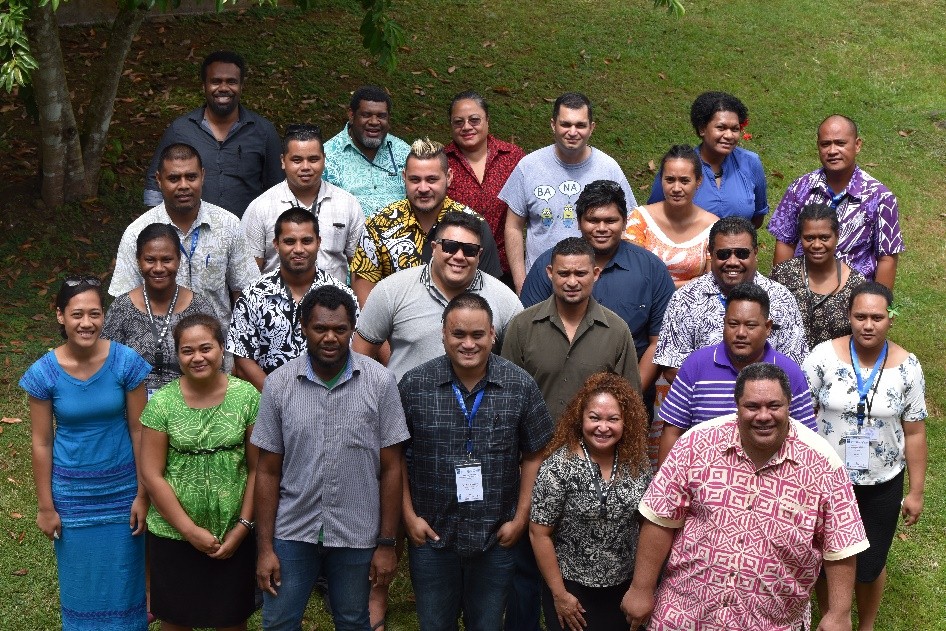
Climate Change Resilience
The Australian Aid funded Climate and Oceans Support Programme for the Pacific (COSPPac) project, commenced its specialized training of Pacific Climate Officers on the use of the Seasonal Climate Outlooks in Pacific Islands Countries (SCOPIC) tool yesterday at SPREP training centre in Vailima.
SCOPIC is a decision making support tool that generates seasonal outlooks for rainfall, temperature and other climate-related factors relevant for the Pacific region. It also contains a Drought Monitoring Module. This tool has being made available to the National Meteorological and Hydrological Services (NMHSs) of the 14 Pacific island Countries through support by the Government of Australia.
"The focus of the training this week will be to strengthen the understanding of the climate officers on SCOPIC and its potential to generate information to be used by different users including sectors, stakeholders as well as the public" says, Bureau of Meteorology (BoM) Climatologist, Simon McGree.

Participants of the COSPPac SCOPIC training held at the SPREP headquarters. Photo: SPREP
The same sentiments was echoed by SPREP's Climate Change Division Officer in Charge, Mr. Salesa Nihmei during his opening remarks, "encouraging the participants to take advantage of this great opportunity to understand SCOPIC as a decision tool but to also learn from each other on the challenges and opportunities".
Through the COSPPac program,SPREP is helping the region to strengthen climate information services for accessing fast and reliable climate data that can be used for appropriate decisions by respective Governments.
COSPPac SCOPIC support is jointly-implemented by the Australian Bureau of Meteorology (BoM) and the Secretariat of the Pacific Regional Environment Programme (SPREP).
SCOPIC was developed by the BoM together with National Meteorological and Hydrological Services (NMHSs) in-order to provide Pacific Island nations with accessible, stand-alone seasonal climate prediction system. The software uses a statistical method to determine forecast probabilities, based on historic data.The software also provides graphics and texts to support the outlooks, including skill tests, hindcasts, data-browsing, statistical analyses, scatter plots, and drought monitoring.

Tonga and Tuvalu climate officers at the COSPPac SCOPIC training. Photo: SPREP
The SCOPIC tool is being used by National Meteorological Services in Pacific Island countries and has recently been introduced to the Palau, Federated States of Micronesia, Nauru and Tokelau NMHSs.
SCOPIC training is one of the two trainings held at SPREP this week. The Second regional training will focus on the Pacific Island Climate Advance Seasonal Outlook (PICASO) facilitated by the APEC Climate Center (APCC) in partnership with SPREP. This will be followed by the Pacific Island Climate Outlook Forum (PICOF) with a focus on the Health Sector. PICOF is a platform for knowledge exchange between the climate officials and different sectors.
More information please contact Philip Malsale philipm@sprep.org or PacMetDeskPartnershippacmetdesk@sprep.org
SCOPIC is a decision making support tool that generates seasonal outlooks for rainfall, temperature and other climate-related factors relevant for the Pacific region. It also contains a Drought Monitoring Module. This tool has being made available to the National Meteorological and Hydrological Services (NMHSs) of the 14 Pacific island Countries through support by the Government of Australia.
"The focus of the training this week will be to strengthen the understanding of the climate officers on SCOPIC and its potential to generate information to be used by different users including sectors, stakeholders as well as the public" says, Bureau of Meteorology (BoM) Climatologist, Simon McGree.

Participants of the COSPPac SCOPIC training held at the SPREP headquarters. Photo: SPREP
The same sentiments was echoed by SPREP's Climate Change Division Officer in Charge, Mr. Salesa Nihmei during his opening remarks, "encouraging the participants to take advantage of this great opportunity to understand SCOPIC as a decision tool but to also learn from each other on the challenges and opportunities".
Through the COSPPac program,SPREP is helping the region to strengthen climate information services for accessing fast and reliable climate data that can be used for appropriate decisions by respective Governments.
COSPPac SCOPIC support is jointly-implemented by the Australian Bureau of Meteorology (BoM) and the Secretariat of the Pacific Regional Environment Programme (SPREP).
SCOPIC was developed by the BoM together with National Meteorological and Hydrological Services (NMHSs) in-order to provide Pacific Island nations with accessible, stand-alone seasonal climate prediction system. The software uses a statistical method to determine forecast probabilities, based on historic data.The software also provides graphics and texts to support the outlooks, including skill tests, hindcasts, data-browsing, statistical analyses, scatter plots, and drought monitoring.

Tonga and Tuvalu climate officers at the COSPPac SCOPIC training. Photo: SPREP
The SCOPIC tool is being used by National Meteorological Services in Pacific Island countries and has recently been introduced to the Palau, Federated States of Micronesia, Nauru and Tokelau NMHSs.
SCOPIC training is one of the two trainings held at SPREP this week. The Second regional training will focus on the Pacific Island Climate Advance Seasonal Outlook (PICASO) facilitated by the APEC Climate Center (APCC) in partnership with SPREP. This will be followed by the Pacific Island Climate Outlook Forum (PICOF) with a focus on the Health Sector. PICOF is a platform for knowledge exchange between the climate officials and different sectors.
More information please contact Philip Malsale philipm@sprep.org or PacMetDeskPartnershippacmetdesk@sprep.org